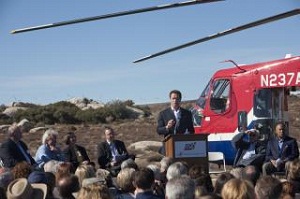Solar transmission line met with some jeers
 On Dec. 9, 2010, as outgoing California Gov. Arnold Schwarzenegger (R) attended the ground-breaking ceremony, construction got underway on the Sunrise Powerlink transmission line. But detractors of the project, were also on hand to protest the power lines.
On Dec. 9, 2010, as outgoing California Gov. Arnold Schwarzenegger (R) attended the ground-breaking ceremony, construction got underway on the Sunrise Powerlink transmission line. But detractors of the project, were also on hand to protest the power lines.
The line is intended to carry renewable electricity from the planned 709 megawatt (MW) Imperial Valley Solar Plant. However, the power plant may be imperiled by a lack of funding and at least one engineer contends that the Sempra’s San Diego Gas & Electric (SDG&E) could better spend the money on distributed generation, rather than large solar thermal projects.
The Imperial Valley Solar project was approved by the Bureau of Land Management (BLM) and the California Energy Commission (CEC) earlier this year. The developer, Imperial Valley Solar LLC, had hoped to start construction by Dec. 31 in order to qualify for about $600 million in federal grants. But now it is unsure if it will be able to meet that deadline and is hoping the grants are extended. If not, the Sunrise Powerlink’s lines may need to find other suppliers for their 1,000 MW carrying capacity.
Even without it, the SDG&E will add on 500 MWs of renewable generation to its grid, said SDG&E spokesperson, Art Larson.
“We understand there’s some challenges that Teserra Solar is having,” he said. “We’re hopeful that they can continue to move forward with that project.”
The utility has about 600 more MWs of renewable energy under negotiation in the Imperial Valley, he said.
The Sunrise Powerlink project has withstood numerous legal challenges at all stages, said Larson. It was challenged in the permitting process, including the BLM and CEC.
“We only have on major line running into San Diego,” he said, “and it’s tantamount to get more.”
Bill Powers, CEO of Powers Engineering, a lead opponent of the Sunrise Powerlink and the Imperial Valley Solar project said that neither the 117-mile power line, with its $1.9 billion price tag, nor the solar farm is necessary.
SDG&E is investing in the transmission lines and agreed to buy the power from the power plant in an attempt to meet its renewable energy requirements under the state’s renewable portfolio standard.
“The economies of scale are not there with the transmission costs and line costs,” Powers said. “That transmission line is a golden parachute for SDG&E.”
He said that the company would make profits off the transmission line while charging customers extra for financing the lines.
Powers said that by using existing lines and distributed generation, SDG&E could add in the 1,000 MWs.
“There’s no question that they could do it a lot faster than [2020]. They’re already at about 15 percent renewables with no distributed PV,” he said.
The utility could add in 600 MWs of PV on commercial rooftops, not residences, to meet the utility’s renewables needs, Powers said. He also said that it would be cheaper to develop than the Imperial project.
Large-scale distributed generation cost is 22 cents per kilowatt hour (kWh) in 2010, and it will drop to a little less than 21 cents per kWh in 2011, according to Powers. Whereas the cost of large-scale solar thermal projects is projected at 25 cents per kWh produced, he said.
And Larson is aware of Powers’ opposition.
“He’s entitled to his opinion. We’ve made a commitment to get to 33 percent by 2020,” he said. “We not only need this transmission line to get this power, we’re gonna to need some more power. We need it all to make that 33 percent commitment.”
Image courtesy of California's governor's office.



